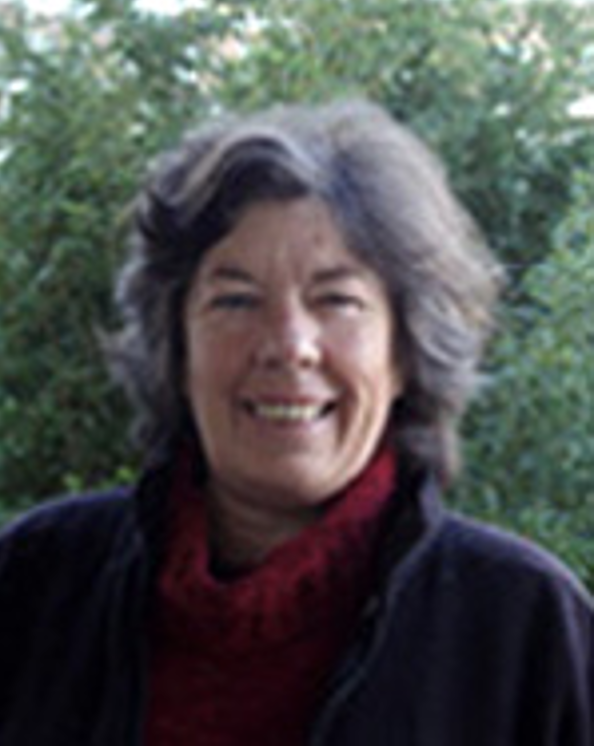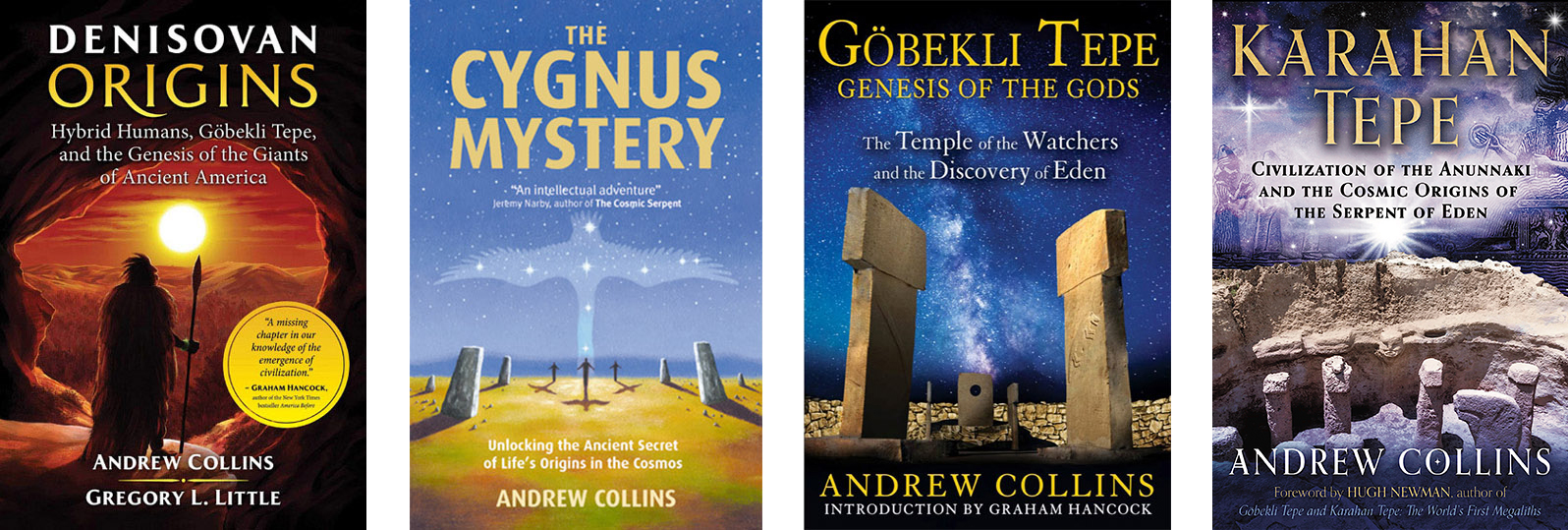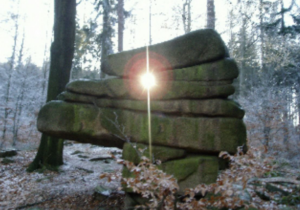The projects and works that we publish through Arcane Landscape Trust would not be possible without the generous support and expertise of a whole host of highly respected writers, researchers and champions of the hidden landscape. We extend our thanks and gratitude for their invaluable input and we hope that you enjoy their work as much as we do.
Dr. John Grigsby
 Senior Archaeologist, Canterbury Archaeological Trust
Senior Archaeologist, Canterbury Archaeological Trust
John is a lecturer and author in the fields of archaeology and myth. He received his doctorate in 2019 for his investigation into the mysterious henge monuments of Prehistoric Britain, which he demonstrated were aligned on the Milky Way, identified in this period with a long-forgotten goddess of death and rebirth. His work both reconstructs the lost myth of this Neolithic goddess and the probable function of the henges and stone circles.
Read more: www.johngrigsby.weebly.com

Dr. Linda L. Therkorn
 Dr. Linda L. Therkorn is a scholar who completed her doctoral degree at the University of Amsterdam (Amsterdam Archaeological Centre). Her thesis “Landscaping the Powers of Darkness & Light: 600 BC – 350 AD: Settlement Concerns of Noord-Holland in Wider Perspective”, was published in December 2004.
Dr. Linda L. Therkorn is a scholar who completed her doctoral degree at the University of Amsterdam (Amsterdam Archaeological Centre). Her thesis “Landscaping the Powers of Darkness & Light: 600 BC – 350 AD: Settlement Concerns of Noord-Holland in Wider Perspective”, was published in December 2004.
This influencial work explores the relationship between archaeological settlement patterns, spatial organization, burial practices, constellations and celestial events, and ritualistic activities of early societies.
Dr Therkorn documented a ‘landscape of the sky’ and found that settlement formations revealed deposits in burial pits that related to large scale patterns, forming shapes that represented the stars, creating recognizable patterns of the constellations.
You can download Dr Therkorn’s “Landscaping the Powers of Darkness & Light” for free below: Download > Landscaping the Powers of Darkness & Light
Andrew Collins
 Andrew Collins is a science and history writer, who has been investigating the origins of human civilization for over three decades. He is a noted explorer and the co-discoverer of a massive cave complex beneath the Giza plateau, now known as “Collins’ Caves.” He is the author of several bestselling books including The Black Alchemist, The Seventh Sword, From the Ashes of Angels, Gods of Eden, Gateway to Atlantis, Tutankhuman: The Exodus Conspiracy, co-authored with Chris Ogilvie Herald, The Cygnus Mystery, Göbekli Tepe: Genesis of the Gods, The Cygnus Key: The Denisovan Legacy, Göbekli Tepe and the Birth of Egypt, Denisovan Origins: Hybrid Humans, Göbekli Tepe and the Genesis of the Giants of Ancient America, co-authored with Greg L. Little, and Karahan Tepe: Civilisation of the Annunaki and the Cosmic Origins of the Serpent of Eden.
Andrew Collins is a science and history writer, who has been investigating the origins of human civilization for over three decades. He is a noted explorer and the co-discoverer of a massive cave complex beneath the Giza plateau, now known as “Collins’ Caves.” He is the author of several bestselling books including The Black Alchemist, The Seventh Sword, From the Ashes of Angels, Gods of Eden, Gateway to Atlantis, Tutankhuman: The Exodus Conspiracy, co-authored with Chris Ogilvie Herald, The Cygnus Mystery, Göbekli Tepe: Genesis of the Gods, The Cygnus Key: The Denisovan Legacy, Göbekli Tepe and the Birth of Egypt, Denisovan Origins: Hybrid Humans, Göbekli Tepe and the Genesis of the Giants of Ancient America, co-authored with Greg L. Little, and Karahan Tepe: Civilisation of the Annunaki and the Cosmic Origins of the Serpent of Eden.
Andrew’s books challenge the way we perceive the past and feature such subjects as ancient astronomy, archaeoastronomy and the origins of civilization. A central theme of Collins’s books is that the Watchers and Nephilim of Enochian literature, as well as the biblical “fallen” angels and Anunnaki of Mesopotamian mythology, are memories of a human elite group that helped forge the foundations of civilization in Anatolia and the Near East. He asserts that this same region, particularly eastern Turkey, was the site of the biblical Garden of Eden and terrestrial Paradise.
Andrew’s new monograph ‘The Stonehenge Altar Stone: Its Origins, Composition, and Function, and the Search for its Lost Companion’ can be downloaded for free below:
Download > The Stonehenge Altar Stone
Read more: www.andrewcollins.com

Dennis Doxtater
Professor Emeritus of Architecture, University of Arizona

Dennis Doxtater is currently researching the positioning of archaeological sites in large-scale contexts of landscape geometry, i.e. “georitual” in the Native American Southwest, on Minoan Crete and in Scandinavia. Before becoming emeritus, he recently taught a specialized design studio using custom software to investigate the symbolic linkage of large-scale landscapes to contemporary architectural settings, e.g. interpretative centres and spiritual settings such as spas, churches, residences, community foci, etc.
Works include: ‘Parallel Universes on the Colorado Plateau’, ‘Yggdrasil as Map: precedents for a large-scale Eliadian cross structure in prehistoric Scandinavia and probabilities of integration with locations of largest mounds’, and ‘Rethinking the Sacred Landscape’.
Coming soon: ‘Chaco’s Place in the Formalized Landscape’ – People who make the thirty-mile dirt road trip to this modest canyon in New Mexico take countless photos of the most monumental prehistoric architecture in the U.S. What visitors miss, however, is the way the canyon wall between the two largest pueblos, called “Curved Rock That Speaks” echoes when spoken to from the center of the plaza like space. Analysis of possible surveyed large-scale alignments and other geometries across the Colorado Plateau, however, suggests that as much as 400 years before the big buildings began to emerge, this natural plaza was one of several regional foci, at Chaco architecturally flanked only by two great kivas at the north and south ends of the canyon. Paradoxically, this immediately impressive architecture and planning is less a religious apex, then a media shift representing the plateau landscape itself – where for centuries spiritual power from prominent natural features flowed to dispersed, socially integrated great kiva sites with very modest, subordinate pueblo room blocks. These formalized landscape frames are not borrowed from myth in the first instance, but evolve from more primary meanings and relationships bound to actual movements in social space at scales of cyclical time. Were full understandings of precedent formal landscapes well interpreted in classrooms, museums and especially the landscape in which we live, then our text and architecture based discursive beliefs about religion might be less fraught with conflict.
Read more: www.capla.arizona.edu/faculty-staff/dennis-doxtater
Dr Helen Lacey
 Senior Tutor and Associate Professor in Late Medieval History
Senior Tutor and Associate Professor in Late Medieval History
Helen Lacey’s research interests centre on later medieval political culture, the social context of the law and the political engagement of marginalised groups. She is currently Co-Investigator on the major AHRC-funded project, The People of 1381.
Helen’s insight was greatly appreciated in informing the research of Arcane Landscape Trust’s next major project, ‘Staverton – Part 2: Landscapes and Skyscapes’ due for publication in 2025.
Read more:
www.mansfield.ox.ac.uk/subjects/history/?profile=2613
David Warner Mathisen
 David Warner Mathisen has been exploring the connections between the ancient myths and the stars for over a decade and has authored eight books and dozens of videos documenting the system of celestial metaphor which forms the foundation for the myths, scriptures and sacred stories of cultures around the globe.
David Warner Mathisen has been exploring the connections between the ancient myths and the stars for over a decade and has authored eight books and dozens of videos documenting the system of celestial metaphor which forms the foundation for the myths, scriptures and sacred stories of cultures around the globe.
This evidence demonstrates the existence of an advanced esoteric system which was already fully mature by the time of the earliest extant texts known to conventional academia (including the texts from the oldest known civilizations such as ancient Mesopotamia, ancient Egypt, ancient India and ancient China), and which can also be found operating in the myths of cultures in Africa, Australia, the Americas, and the islands of the Pacific.

David is convinced that this ancient system was intended to convey profound truths which are today more relevant than ever to our lives, even in this very present moment – and that one of the core messages of the ancient myths involves the recovery of the essential or authentic self, from whom we become alienated by what is today referred to as psychological trauma.
David is a graduate of the United States Military Academy at West Point and has a masters degree in English literature from Texas A&M University. He has been an instructor in the Department of English and Philosophy at West Point and lives in his home state of California, where he enjoys surfing and watching the stars.
Links to discussions of over eighty different Star Myths, as well as discussions of many other related topics, and details of David’s books can be found on his website.
Read more: www.starmythworld.com
Dr. James Ogier
Emeritus Professor of German and Linguistics, Roanoke College
 James Ogier received his Ph.D. in Germanic Philology from the University of Pennsylvania in 1981 and is now retired from his position as Professor of German and Linguistics at Roanoke College in Salem, VA. He has also studied at the universities of Bonn, Copenhagen, and Iceland. His publications deal principally with aspects of the poetry of Oswald von Wolkenstein and Michel Beheim, but his extensive experience with Scandinavia has also resulted in articles on Scandinavian mythology and a book-length novel translation. Among his teaching interests are historical linguistics, ancient Maya culture and glyphic texts, and the Icelandic Sagas. He lives in Blacksburg, VA.
James Ogier received his Ph.D. in Germanic Philology from the University of Pennsylvania in 1981 and is now retired from his position as Professor of German and Linguistics at Roanoke College in Salem, VA. He has also studied at the universities of Bonn, Copenhagen, and Iceland. His publications deal principally with aspects of the poetry of Oswald von Wolkenstein and Michel Beheim, but his extensive experience with Scandinavia has also resulted in articles on Scandinavian mythology and a book-length novel translation. Among his teaching interests are historical linguistics, ancient Maya culture and glyphic texts, and the Icelandic Sagas. He lives in Blacksburg, VA.
James is a prolific editor, translator and writer and include works such as ‘Islands and Cities in Medieval Myth, Literature, and History’, ‘Islands and Skylands: An Eddic Geography’ and articles published in ‘Medieval Germany: An Encyclopedia’.
He has also presented a diverse range of academic lectures including ‘Two-faced (Diprosonus) Solstice Symbols and the World Tree’, ‘Misinterpretatio Romana et Interpretatio Germanica Astronomica’, ‘Germanic Mythology as Astronomy’ and ‘Eddic Constellations’.
Current research interests include: Ancient and Medieval Germanic and Finno-Ugric Astronomy.
Read more: www.roanoke.academia.edu/JamesOgier
Amelia Carolina Sparavigna
 Amelia Carolina Sparavigna is an Assistant Professor in Physics, at the Department of Applied Science and Technology of the Polytechnic University of Turin and is Doctor of Philosophy in Physics and is a Master in Physics.
Amelia Carolina Sparavigna is an Assistant Professor in Physics, at the Department of Applied Science and Technology of the Polytechnic University of Turin and is Doctor of Philosophy in Physics and is a Master in Physics.
Whilst Amelia studies condensed and soft matter, with a special interest in thermal transport and liquid crystalline materials, she has developed a personal and professional interest in archaeoastronomy and continues to publish her studies on ancient sites from around the world.
It was in 2015 that Amelia published her excellent study on Hardknott Fort, an ancient, square-shaped fortress located atop a hill near Hardknott Pass in Cumbria and its solstitial alignments, as well observing that the towers situated at each corner of the fortress were aligned with the cardinal directions. Read this and her paper on ‘The Winter Solstice and the Mithraeum at Brocolitia, Carrawburgh’ in our Library.
Bob Trubshaw
 Bob Trubshaw founded Heart of Albion Press in 1989 to publish his research into aspects of Leicestershire and Rutland local history – such as holy wells, standing stones, ancient crosses, and medieval church carvings. Fairly quickly this led to publishing books and booklets for other authors. The range of titles evolved over thirty-plus years and, for the last decade or so, his own published work has mostly shared interdisciplinary approaches to sixth and seventh century England – the so-called ‘Conversion Era’. Most of his books are now available as free PDFs.
Bob Trubshaw founded Heart of Albion Press in 1989 to publish his research into aspects of Leicestershire and Rutland local history – such as holy wells, standing stones, ancient crosses, and medieval church carvings. Fairly quickly this led to publishing books and booklets for other authors. The range of titles evolved over thirty-plus years and, for the last decade or so, his own published work has mostly shared interdisciplinary approaches to sixth and seventh century England – the so-called ‘Conversion Era’. Most of his books are now available as free PDFs.
See www.hoap.co.uk/index.htm for details.
Bob has also compiled over fifty YouTube videos – see www.youtube.com/@BobTrubshaw
For the compleatists among you there’s a full list of Bob’s books, booklets, articles and videos here: www.indigogroup.co.uk/trubshaw/bibliography.htm
Bruno-H.-Bürgel Observatory, Sohland/Spree e.V.
 Ralf Herold
Ralf Herold
- Member of the Bruno-H.-Bürgel Observatory, Sohland/Spree e.V.
- Assessor on the board, co-founder and head of the Archaeoastronomy Department of the Sohland/Spree Observatory.
- Speaker, lecturer and publicist for historical and astronomical topics.
Dr. Hilmar Hensel
- Board member of the Bruno-H.-Bürgel Observatory, Sohland/Spree e.V.
- Co-founder and member of the Archaeoastronomy specialist group.
Read more: www.sternwarte-sohland.de
and www.goetterhand.de
Stephen Pollington
 Stephen Pollington has been writing books on early mediaeval topics since 1990 when his ‘The Warrior’s Way’ was published to coincide with the thousand-year anniversary of the battle at Maldon, Essex, in 991 AD. The battle is commemorated in a lengthy Old English poem which Stephen translated and used as the central platform for a discussion of the later Viking Age in England. The book was published by Blandford Press, an imprint of Cassell.
Stephen Pollington has been writing books on early mediaeval topics since 1990 when his ‘The Warrior’s Way’ was published to coincide with the thousand-year anniversary of the battle at Maldon, Essex, in 991 AD. The battle is commemorated in a lengthy Old English poem which Stephen translated and used as the central platform for a discussion of the later Viking Age in England. The book was published by Blandford Press, an imprint of Cassell.
A long-term association with the newly-founded Anglo-Saxon Books began at this time, which resulted in publication of two small volumes: ‘Rudiments of Runelore’ and ‘An Introduction to the Old English Language and its Literature’. ‘Rudiments’, as it is now usually known, proved a popular and inexpensive introduction to the subject. Following this, Stephen devised a topic-specific dictionary – from Modern to Old English, something which had not been attempted since the 19th century. ‘Wordcraft’ became popular with students wishing to compose verse or prose in Old English, as well as with re-enactors and living historians wanting to acquire some specific vocabulary: medical, military, commercial, religious and the like.
A more detailed work followed, ‘The English Warrior’, centred on the role of the military in early mediaeval times as well as the equipment used (swords, spears, mailcoats and helmets) and the life of military men on and off the battlefield. Discussion touched on the superstitions and beliefs surrounding warfare, a subject to which Stephen returned some years later in ‘Elder Gods’. A detailed textual treatment of medical practice was the next project, ‘Leechcraft’, in which three important medical documents (Old English Herbarium, Lacnunga, Bald’s Leechbook III) were offered in the original with facing-page translations, accompanied by an outline of herbal medicine, surgery, charms and incantations and many other topics which impinge on the practice of healing.
Mediaeval social life centred around the institution known as the ‘mead-hall’ and the distribution of strong drink as a social event, which was the focus for Stephen’s next work: ‘Mead Hall: The Feasting Tradition in Anglo-Saxon England’. Alongside quotations from Old English, Latin and Norse documents with translations, Stephen took the opportunity to discuss the archaeological evidence for physical structures, the vessels used to create and distribute strong drink, the forms and meanings of the rituals undertaken and their importance in maintaining social structures. The book proved very popular and has been reprinted several times.
Students wishing to learn Old English are often faced with a mass of terminology which becomes a barrier to understanding. To get round this problem, Stephen developed a language course aimed at students working without a tutor: ‘First Steps in Old English’. The idea was to provide only as much grammar as is necessary to understand the language. The book is also sold alongside two CDs of readings in the language. Stephen’s voice recordings have been used in a number of television and radio programmes, where his readings from poetry and the Chronicle have been very popular.
In order to set in context the aristocratic burials known from Anglo-Saxon times, a study was produced outlining the practice of mound-burial alongside a regional listing of the known ‘barrows’ as they are called, many of which no longer exist. The book ‘Anglo-Saxon Burial Mounds’ resulted from Stephen’s attempts to locate them in the modern landscape using archaeology and place-name evidence. Archaeology and literary evidence were also used in combination for the wide-ranging study of art and material culture in northern Europe from the Iron Age into the mediaeval period: ‘Wayland’s Work: Anglo-Saxon Art, Myth and Material Culture from the 4th to the 7th century’. A study (with Paul Mortimer) of the mysterious ‘stone’ from Sutton Hoo was produced examining how the item was made – based on the production of a museum-quality replica by two modern craftsmen: ‘Remaking the Sutton Hoo Stone’. The study of myth and how it is possible to tease out details of historical facts, legends and myths formed the inspiration for ‘Elder Gods: The Otherworld in Early England’.
A two-volume work on runes (Runes: L’Ecriture des Anciens Germains) was produced in French expanded from a wide-ranging survey ‘Runes: Literacy in the Germanic Iron Age’. Stephen has returned to the subject of runic studies in his most recent offering: ‘Runes: A Guide to Their History and Usage’ which is published by Chesterwell Press.
Alongside book writing, Stephen teaches Old English (both language and cultural history) with the City Literary Institute, London. He lives near the ancient city of Colchester and explores the surrounding countryside with a historical eye.
Read more: Stephen’s Books on Amazon
Griffmonsters Great Walks
Set yourself free and explore the great British countryside.
There are hundreds of walks on Griff’s site that offer guidance and inspiration to get out there and explore. Although the site focuses predominantly on East Anglia, it also offers walks from other areas of the UK including trails such as the South West Coast Path and the Cleveland Way.
Fully detailed walks offer full and complete information including transport details, pubs on route and maps of the walk. These also provide in-depth research of a specific topic that is featured on the walk. Such features can range from local folklore, local history or just information on key features that are encountered along the route.
We love Griff’s site and he’s really done his leg work in our home county.
Read more: www.griffmonster-walks.blogspot.com

